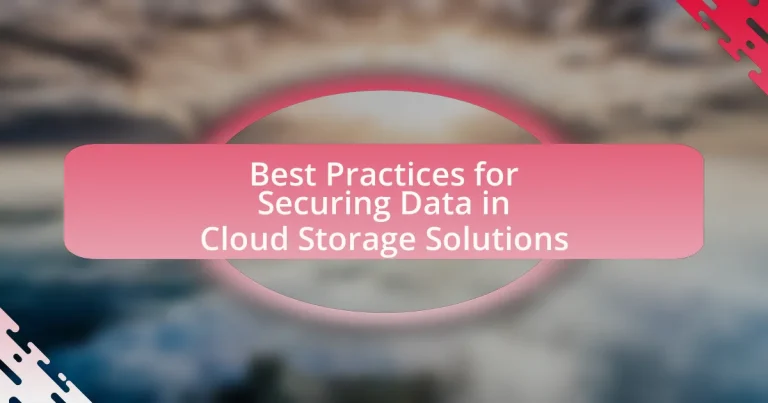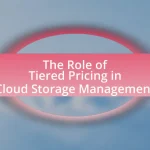The article focuses on best practices for securing data in cloud storage solutions, emphasizing the importance of strong encryption, multi-factor authentication, regular access control updates, and frequent security audits. It outlines how these practices enhance data security by protecting against threats such as data breaches and unauthorized access while ensuring compliance with regulations like GDPR and HIPAA. Additionally, the article discusses the role of access controls, encryption methods, and ongoing maintenance practices in safeguarding sensitive information, as well as the potential risks associated with inadequate security measures.
What are the Best Practices for Securing Data in Cloud Storage Solutions?
The best practices for securing data in cloud storage solutions include implementing strong encryption, utilizing multi-factor authentication, regularly updating access controls, and conducting frequent security audits. Strong encryption protects data both at rest and in transit, ensuring that unauthorized users cannot access sensitive information. Multi-factor authentication adds an additional layer of security by requiring multiple forms of verification before granting access. Regularly updating access controls helps to ensure that only authorized personnel have access to specific data, reducing the risk of data breaches. Frequent security audits identify vulnerabilities and ensure compliance with security policies, thereby enhancing overall data protection.
How do these best practices enhance data security?
Best practices enhance data security by implementing robust measures that protect sensitive information from unauthorized access and breaches. For instance, encryption ensures that data is unreadable without the correct decryption key, significantly reducing the risk of data theft. Additionally, regular security audits identify vulnerabilities in the system, allowing organizations to address potential weaknesses proactively. Multi-factor authentication adds an extra layer of security by requiring multiple forms of verification before granting access, which has been shown to reduce the likelihood of unauthorized access by up to 99.9%. These practices collectively create a fortified environment that safeguards data integrity and confidentiality.
What specific threats do these practices address?
These practices address specific threats such as data breaches, unauthorized access, data loss, and compliance violations. Data breaches occur when sensitive information is accessed without authorization, often due to weak security measures. Unauthorized access can result from inadequate authentication protocols, allowing malicious actors to exploit vulnerabilities. Data loss may happen due to accidental deletion, hardware failure, or cyberattacks, emphasizing the need for robust backup solutions. Compliance violations arise when organizations fail to adhere to regulations governing data protection, which can lead to legal penalties and reputational damage. Implementing best practices mitigates these threats by enhancing security protocols, ensuring data integrity, and maintaining compliance with relevant laws.
How do these practices align with compliance requirements?
These practices align with compliance requirements by ensuring that data protection measures meet regulatory standards such as GDPR, HIPAA, and PCI-DSS. Implementing encryption, access controls, and regular audits directly addresses the mandates of these regulations, which require organizations to safeguard sensitive information and maintain data integrity. For example, GDPR mandates that personal data must be processed securely, and using encryption as a best practice helps fulfill this requirement by protecting data from unauthorized access.
Why is data security crucial in cloud storage?
Data security is crucial in cloud storage because it protects sensitive information from unauthorized access, breaches, and data loss. With the increasing reliance on cloud services, organizations face heightened risks of cyberattacks, making robust security measures essential. According to a 2021 report by Cybersecurity Ventures, cybercrime is projected to cost the world $10.5 trillion annually by 2025, underscoring the importance of securing data in cloud environments. Effective data security practices, such as encryption and access controls, help mitigate these risks and ensure compliance with regulations like GDPR and HIPAA, which mandate the protection of personal and sensitive data.
What are the potential risks of inadequate data security?
Inadequate data security poses significant risks, including data breaches, financial loss, and reputational damage. Data breaches can lead to unauthorized access to sensitive information, resulting in identity theft and fraud. Financial loss can occur due to regulatory fines, legal fees, and the costs associated with remediation efforts. Reputational damage can undermine customer trust and lead to a decline in business. According to a 2020 report by IBM, the average cost of a data breach is $3.86 million, highlighting the financial implications of inadequate security measures.
How can data breaches impact organizations?
Data breaches can severely impact organizations by compromising sensitive information, leading to financial losses, reputational damage, and legal consequences. For instance, the 2017 Equifax breach exposed personal data of approximately 147 million individuals, resulting in over $4 billion in costs related to remediation and legal settlements. Additionally, organizations may face regulatory fines, as seen with the GDPR penalties, which can reach up to 4% of annual global revenue. The loss of customer trust following a breach can also lead to decreased sales and long-term damage to brand reputation.
What are the key components of effective data security in cloud storage?
The key components of effective data security in cloud storage include encryption, access control, data integrity, and regular security audits. Encryption protects data by converting it into a secure format that can only be read by authorized users, ensuring confidentiality. Access control mechanisms, such as multi-factor authentication and role-based access, limit who can access sensitive information, reducing the risk of unauthorized access. Data integrity measures, including checksums and hashing, verify that data has not been altered or tampered with during storage or transmission. Regular security audits help identify vulnerabilities and ensure compliance with security policies and regulations, thereby enhancing overall security posture.
How does encryption contribute to data security?
Encryption enhances data security by converting information into a coded format that is unreadable without a decryption key. This process protects sensitive data from unauthorized access, ensuring that even if data is intercepted during transmission or accessed from a compromised storage system, it remains secure. For instance, according to a 2021 report by the Ponemon Institute, organizations that implemented encryption experienced 50% fewer data breaches compared to those that did not. This demonstrates that encryption is a critical component in safeguarding data integrity and confidentiality in cloud storage solutions.
What types of encryption are commonly used?
Commonly used types of encryption include symmetric encryption, asymmetric encryption, and hashing. Symmetric encryption, such as AES (Advanced Encryption Standard), uses the same key for both encryption and decryption, making it efficient for large data sets. Asymmetric encryption, exemplified by RSA (Rivest-Shamir-Adleman), employs a pair of keys—one public and one private—allowing secure key exchange and digital signatures. Hashing algorithms, like SHA-256 (Secure Hash Algorithm), transform data into a fixed-size string of characters, ensuring data integrity by producing a unique hash for each input. These encryption methods are foundational in securing data in cloud storage solutions, protecting sensitive information from unauthorized access.
How does encryption protect data at rest and in transit?
Encryption protects data at rest and in transit by converting it into a format that is unreadable without the appropriate decryption key. For data at rest, encryption secures stored information, such as files on a hard drive or cloud storage, ensuring that unauthorized users cannot access or interpret the data even if they gain physical access to the storage medium. For data in transit, encryption safeguards information being transmitted over networks, such as emails or online transactions, by preventing interception and unauthorized access during transmission. This is evidenced by the use of protocols like TLS (Transport Layer Security), which encrypts data during transfer, making it difficult for attackers to decipher the information.
What role do access controls play in securing data?
Access controls are essential in securing data as they regulate who can view or use information within a system. By implementing access controls, organizations can ensure that only authorized users have access to sensitive data, thereby reducing the risk of data breaches and unauthorized access. For instance, a study by the Ponemon Institute found that 63% of data breaches are due to weak or stolen credentials, highlighting the importance of robust access control measures. These controls can include user authentication, role-based access permissions, and regular audits to monitor access patterns, all of which contribute to a more secure data environment.
How can organizations implement role-based access controls?
Organizations can implement role-based access controls (RBAC) by defining user roles and assigning permissions based on those roles. This process begins with identifying the various roles within the organization, such as administrator, user, and guest, and determining the specific access needs for each role. Once roles are established, organizations can utilize access control systems to enforce these permissions, ensuring that users can only access data and resources necessary for their job functions.
For instance, a study by the National Institute of Standards and Technology (NIST) emphasizes that RBAC enhances security by minimizing unnecessary access, thereby reducing the risk of data breaches. By regularly reviewing and updating roles and permissions, organizations can maintain effective access control that adapts to changing business needs and security threats.
What are the best practices for managing user permissions?
The best practices for managing user permissions include implementing the principle of least privilege, regularly reviewing access rights, and utilizing role-based access control (RBAC). The principle of least privilege ensures that users have only the permissions necessary to perform their job functions, minimizing the risk of unauthorized access. Regularly reviewing access rights helps identify and revoke unnecessary permissions, reducing potential vulnerabilities. Role-based access control streamlines permission management by assigning access based on user roles, which simplifies oversight and enhances security. These practices are supported by security frameworks such as NIST SP 800-53, which emphasizes the importance of access control in safeguarding sensitive data.
What are the common tools and technologies for securing cloud storage?
Common tools and technologies for securing cloud storage include encryption, access controls, and multi-factor authentication. Encryption protects data by converting it into a secure format that can only be read by authorized users, ensuring confidentiality. Access controls manage who can view or use the data, often utilizing role-based access to limit permissions. Multi-factor authentication adds an additional layer of security by requiring users to provide two or more verification factors to gain access, significantly reducing the risk of unauthorized access. These methods are widely recognized as essential components in safeguarding cloud storage against data breaches and unauthorized access.
How do firewalls and intrusion detection systems enhance security?
Firewalls and intrusion detection systems enhance security by monitoring and controlling incoming and outgoing network traffic based on predetermined security rules. Firewalls act as a barrier between trusted internal networks and untrusted external networks, blocking unauthorized access while allowing legitimate traffic. Intrusion detection systems complement this by analyzing network traffic for suspicious activity and potential threats, alerting administrators to possible breaches. Together, these technologies create a multi-layered defense strategy that significantly reduces the risk of data breaches and unauthorized access, thereby protecting sensitive information stored in cloud solutions.
What features should organizations look for in these tools?
Organizations should look for features such as robust encryption, access controls, and compliance certifications in cloud storage solutions. Robust encryption ensures that data is protected both at rest and in transit, making it unreadable to unauthorized users. Access controls allow organizations to manage who can view or edit data, reducing the risk of data breaches. Compliance certifications, such as ISO 27001 or GDPR, demonstrate that the cloud provider adheres to industry standards for data protection, ensuring that organizations meet regulatory requirements. These features collectively enhance the security posture of organizations utilizing cloud storage solutions.
How can these tools be integrated into existing systems?
These tools can be integrated into existing systems through APIs, middleware, and direct database connections. APIs allow seamless communication between the tools and existing applications, enabling data exchange and functionality enhancement. Middleware can facilitate integration by acting as a bridge, ensuring compatibility between different systems. Direct database connections enable tools to access and manipulate data stored in existing databases, streamlining workflows. For example, cloud storage solutions often provide SDKs that simplify the integration process, allowing developers to implement security features like encryption and access controls directly into their applications.
What are the benefits of using multi-factor authentication?
Multi-factor authentication (MFA) significantly enhances security by requiring users to provide two or more verification factors to gain access to an account. This method reduces the risk of unauthorized access, as it is much harder for attackers to compromise multiple authentication factors simultaneously. For instance, a study by the Cybersecurity & Infrastructure Security Agency (CISA) found that MFA can block over 99% of automated attacks, demonstrating its effectiveness in protecting sensitive data in cloud storage solutions.
How does multi-factor authentication reduce the risk of unauthorized access?
Multi-factor authentication (MFA) significantly reduces the risk of unauthorized access by requiring users to provide multiple forms of verification before granting access to an account. This layered security approach ensures that even if one factor, such as a password, is compromised, unauthorized individuals cannot gain access without the additional verification methods, which may include a text message code, biometric data, or a hardware token. According to a study by the Cybersecurity & Infrastructure Security Agency, implementing MFA can block over 99% of automated cyberattacks, demonstrating its effectiveness in enhancing security and protecting sensitive data in cloud storage solutions.
What are the best practices for implementing multi-factor authentication?
The best practices for implementing multi-factor authentication (MFA) include using a combination of something the user knows (like a password), something the user has (like a smartphone or hardware token), and something the user is (like biometric data). This layered approach significantly enhances security by making it more difficult for unauthorized users to gain access.
Organizations should enforce MFA for all users, especially for those with access to sensitive data or administrative privileges. Regularly updating authentication methods and ensuring that backup codes are securely stored are also critical practices. According to a report by the Cybersecurity & Infrastructure Security Agency, implementing MFA can block up to 99.9% of automated attacks, demonstrating its effectiveness in protecting sensitive information.
What are the ongoing maintenance practices for cloud data security?
Ongoing maintenance practices for cloud data security include regular security assessments, continuous monitoring, and timely updates of security protocols. Regular security assessments help identify vulnerabilities and ensure compliance with industry standards, while continuous monitoring allows for real-time detection of suspicious activities. Timely updates of security protocols, including patch management and configuration changes, are essential to protect against emerging threats. According to the 2021 Cloud Security Report by Cybersecurity Insiders, 93% of organizations consider continuous monitoring critical for cloud security, underscoring its importance in ongoing maintenance practices.
How often should security audits be conducted?
Security audits should be conducted at least annually. This frequency is recommended to ensure that security measures remain effective against evolving threats and vulnerabilities. According to the National Institute of Standards and Technology (NIST), regular audits help organizations identify weaknesses in their security posture and ensure compliance with relevant regulations. Additionally, organizations handling sensitive data may benefit from more frequent audits, such as semi-annually or quarterly, to address specific risks associated with cloud storage solutions.
What updates and patches are necessary for maintaining security?
Regular updates and patches for maintaining security include operating system updates, application updates, and security patches for software vulnerabilities. Operating system updates often address critical security flaws that could be exploited by attackers, while application updates ensure that software remains compatible with the latest security protocols. Security patches are specifically designed to fix vulnerabilities identified in software, and timely application of these patches is crucial; for instance, the 2020 Microsoft Exchange Server vulnerabilities highlighted the importance of prompt patching to prevent exploitation. Regularly applying these updates and patches significantly reduces the risk of security breaches in cloud storage solutions.
What practical tips can organizations follow to secure their cloud data?
Organizations can secure their cloud data by implementing strong access controls, including multi-factor authentication (MFA) and role-based access management. These measures ensure that only authorized personnel can access sensitive information, significantly reducing the risk of unauthorized access. According to a report by the Cloud Security Alliance, 90% of data breaches are due to credential theft, highlighting the importance of robust authentication methods. Additionally, organizations should regularly encrypt their data both in transit and at rest, as encryption protects data from unauthorized access even if it is intercepted. The National Institute of Standards and Technology (NIST) recommends encryption as a fundamental practice for safeguarding sensitive information in cloud environments. Regularly updating and patching software also plays a critical role in maintaining security, as vulnerabilities in outdated software can be exploited by attackers. The Ponemon Institute found that 60% of data breaches are linked to unpatched vulnerabilities, underscoring the necessity of timely updates. Finally, conducting regular security audits and assessments helps organizations identify potential weaknesses in their cloud security posture, allowing for proactive measures to mitigate risks.
How can organizations educate employees about data security?
Organizations can educate employees about data security through comprehensive training programs that include regular workshops, online courses, and awareness campaigns. These initiatives should cover essential topics such as password management, phishing awareness, and secure data handling practices. Research indicates that organizations with ongoing security training see a 70% reduction in security incidents, highlighting the effectiveness of such educational efforts. Additionally, implementing simulated phishing attacks can provide practical experience, reinforcing the importance of vigilance in data security.
What steps should be taken in case of a data breach?
In case of a data breach, the first step is to contain the breach by isolating affected systems to prevent further unauthorized access. Following containment, organizations should assess the extent of the breach by identifying what data was compromised and how the breach occurred. Next, notifying affected individuals and relevant authorities, such as regulatory bodies, is crucial to comply with legal obligations and maintain transparency. Additionally, organizations should conduct a thorough investigation to understand the breach’s cause and implement measures to prevent future incidents. Finally, reviewing and updating security policies and practices is essential to enhance overall data protection. These steps align with industry standards, such as the NIST Cybersecurity Framework, which emphasizes incident response and recovery.


